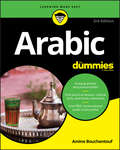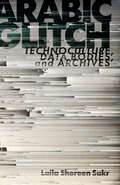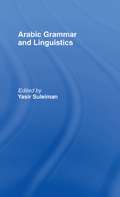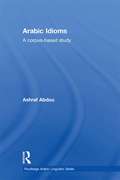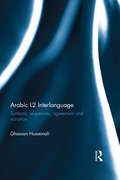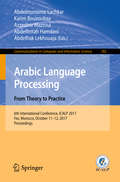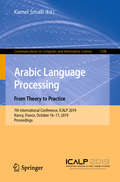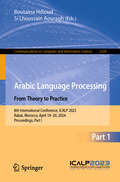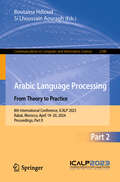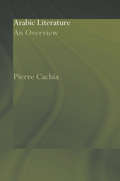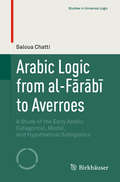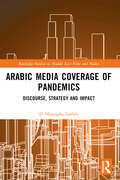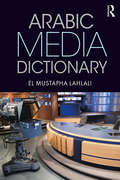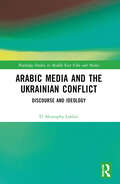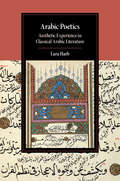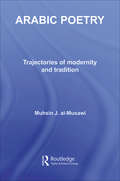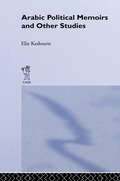- Table View
- List View
Arabic For Dummies
by Amine BouchentoufStart reading and speaking Arabic Arabic For Dummies helps readers start speaking Modern Standard Arabic in no time. Whether you’re a student, traveler, or work in business or government, you’ll find this title to be packed with practical lessons, cultural facts, and handy references. Inside, you’ll find guidance on basic grammar, as well as the necessary vocabulary to make introductions and greetings, use proper etiquette, make small talk, make transportation arrangements, order food and beverages, ask directions, deal with money, shop, access recreation, and handle an emergency. Features new and revised content Offers a revamped, user-friendly design to both pedagogy and organization Includes expanded coverage of grammar, verb conjugations, and pronunciations Get free access to conversational audio tracks online If you want to start speaking Arabic, this go-to book is packed with practical instruction, cultural facts, and handy references you won’t want to be without!
Arabic Genre Pedagogy: Teaching, Learning, and Assessing in Context (Topics in Arabic Applied Linguistics)
by Myriam Abdel-MalekArabic Genre Pedagogy: Teaching, Learning, and Assessing in Context views Modern Standard Arabic and all spoken varieties of Arabic as one system and offers genre-based instructional resources grounded in systemic functional linguistics (SFL) and genre theory. Divided into three parts, this book explores the Theoretical and Instructional Framework, Spoken Genres, and Written Genres with chapters focusing on everyday social genres including exchanging information, chit-chat, and complaints. This book is aligned with the ACTFL framework and the instructional goals for each genre are articulated in terms of the ACTFL Can-Do Statements. Designed to support instructors of Arabic novice-intermediate learners, the chapters offer step-by-step lessons with practical classroom activities on how to make the language related to each genre explicit to students. Arabic Genre Pedagogy serves as a valuable guide and professional development resource for instructors of Arabic as a world language and for researchers of SFL-informed genre-based approach.
Arabic Geometrical Pattern and Design (Dover Pictorial Archive)
by J. BourgoinNearly 200 examples exhibit the wide range of Islamic art, including hexagon and octagon designs, combinations of stars and rosettes, and many variations on other geometric patterns. Twenty-eight examples from traditional sources in Cairo and Damascus include sanctuary doors, openwork windows, and inlaid marble pavements and ceilings.
Arabic Glitch: Technoculture, Data Bodies, and Archives
by Laila Shereen SakrArabic Glitch explores an alternative origin story of twenty-first century technological innovation in digital politics—one centered on the Middle East and the 2011 Arab uprisings. Developed from an archive of social media data collected over the decades following the 2003 U.S. invasion of Iraq, this book interrogates how the logic of programming technology influences and shapes social movements. Engaging revolutionary politics, Arab media, and digital practice in form, method, and content, Laila Shereen Sakr formulates a media theory that advances the concept of the glitch as a disruptive media affordance. She employs data analytics to analyze tweets, posts, and blogs to describe the political culture of social media, and performs the results under the guise of the Arabic-speaking cyborg VJ Um Amel. Playing with multiple voices that span across the virtual and the real, Sakr argues that there is no longer a divide between the virtual and embodied: both bodies and data are physically, socially, and energetically actual. Are we cyborgs or citizens—or both? This book teaches us how a region under transformation became a vanguard for new thinking about digital systems: the records they keep, the lives they impact, and how to create change from within.
Arabic Grammar and Linguistics
by Yasir SuleimanThis book explores aspects of the Arabic Grammatical Tradition and Arabic Linguistics from both a theoretical and descriptive perspective. It also touches on issues of relevance to other disciplines, particularly Qur'anic exegesis and jurisprudence. The links between the fields of language and religion are historically strong in the Arabic and Islamic traditions as so much time and effort was spent by grammarians in interpreting the precise meanings of two of the main sources of Islamic jurisprudence - the Quran and Hadith. Prof Suleiman has assembled an international team of experts in this area and presents a thorough review of the sources and arguments. The book will be of interest to all students, researchers and teachers of Arabic Language and Culture.
Arabic Grammar in Context (Languages in Context)
by Mohammad AlhawaryArabic Grammar in Context offers a unique and exciting approach to learning grammar. It presents grammar as a necessary and essential tool for understanding Arabic and for developing comprehension and production skills. Features include: authentic texts from a rich variety of sources, literary and non-literary, used as the starting point for the illustration and explanation of key areas of Arabic grammar clear and authoritative demonstration of the relevance of grammar for understanding and interpreting Arabic a wide range of appropriate exercises designed to consolidate learning fully vocalized exercises and texts a glossary of vocabulary and expressions provided at the end of the book audio readings of the texts available online for additional listening practice. Suitable for class use and independent study, Arabic Grammar in Context is ideal for intermediate to advanced learners of Arabic.
Arabic Idioms: A Corpus Based Study (Routledge Arabic Linguistics Series)
by Ashraf AbdouIdioms represent a fascinating linguistic phenomenon that has captured the attention of many linguists for decades. This corpus-based study of idioms in Modern Standard Arabic sheds light on their intricate nature, establishes the major patterns of their linguistic behaviour, and provides explanations for these patterns. Adopting a descriptive framework, the study addresses two main issues with regard to the discursive behaviour of idioms: the discursive functions that they perform and the ways in which they contribute to the cohesion of their texts. Examining primary data with regard to the semantic, discursive, lexical and grammatical properties of Arabic idioms, the author touches on the ubiquity of these expressions in language use, the wide range of functions they perform in discourse, the problems they often cause in domains such as foreign language learning and translation, and their typical divergence from the normal rules of grammar and semantic compositionality. Providing explanations for major linguistic phenomena, this analysis will be accessible to linguists, translators, lexicographers, translation software developers, and language teachers as well as learners.
Arabic Islamic Cities Rev: Building and Planning Principles
by Besim Selim HakimFirst published in 1989. Routledge is an imprint of Taylor & Francis, an informa company.
Arabic L2 Interlanguage: Syntactic sequences, agreement and variation (Topics in Arabic Applied Linguistics)
by Ghassan HusseinaliArabic L2 Interlanguage is a significant and timely addition to the field of Second Language Acquisition, providing valuable insight into the development of ‘interlanguage’, the interim language of early beginners, in learners of Arabic. This book: Clearly establishes what interlanguage is and why it should form an important part of foreign language teaching Presents the reader with a sequence in which six English-speaking learners of Arabic acquire the language Makes use of the rich morphological and syntactic property of Arabic to offer a new perspective on the field of Second Language Acquisition. Arabic L2 Interlanguage contributes directly towards building a more comprehensive theoretical framework for explaining how L2s are acquired. It will be key text for SLA scholars as well as an important resource for graduate students in Linguistics and Foreign Language Teaching.
Arabic Language Processing: 6th International Conference, ICALP 2017, Fez, Morocco, October 11–12, 2017, Proceedings (Communications in Computer and Information Science #782)
by Abdelmonaime Lachkar Karim Bouzoubaa Azzedine Mazroui Abdelfettah Hamdani Abdelhak LekhouajaThis book constitutes revised selected papers from the 6th International Conference on Arabic Language Processing, ICALP 2017, held in Fez, Morocco, in October 2017. The 18 full papers presented in this volume were carefully reviewed and selected from 55 submissions. They were organized in topical sections named: machine translation systems; speech recognition and synthesis; text categorization, clustering and summarization; information retrieval systems; and Arabic NLP tools and applications.
Arabic Language Processing: 7th International Conference, ICALP 2019, Nancy, France, October 16–17, 2019, Proceedings (Communications in Computer and Information Science #1108)
by Kamel SmaïliThis book constitutes revised selected papers from the 7th International Conference on Arabic Language Processing, ICALP 2019, held in Nancy, France, in October 2019. The 21 full papers presented in this volume were carefully reviewed and selected from 38 submissions. They were organized in topical sections named: Arabic dialects and sentiment analysis; neural techniques for text and speech; modeling modern standard Arabic; resources: analysis, disambiguation and evaluation.
Arabic Language Processing: 8th International Conference, ICALP 2023, Rabat, Morocco, April 19–20, 2024, Proceedings, Part I (Communications in Computer and Information Science #2339)
by Boutaina Hdioud Si Lhoussain AouraghThis two-volume set, CCIS 2339 and CCIS 2340, constitutes the refereed proceedings of the 8th International Conference on Arabic Language Processing, ICALP 2023, held in Rabat, Morocco, during April 19–20, 2024. The 30 full papers and 11 short papers presented in these two volumes were carefully reviewed and selected from 107 submissions. The papers are organized in the following topical sections: Part I: Learning Arabic and dialectal and Sentiment Analysis; Advancements in Deep Learning for Arabic Language Processing: Generation, Translation, and QA. Part II: Linguistic Resources for Arabic NLP; Various analysis of Arabic.
Arabic Language Processing: 8th International Conference, ICALP 2023, Rabat, Morocco, April 19–20, 2024, Proceedings, Part II (Communications in Computer and Information Science #2340)
by Boutaina Hdioud Si Lhoussain AouraghThis two-volume set, CCIS 2339 and CCIS 2340, constitutes the refereed proceedings of the 8th International Conference on Arabic Language Processing, ICALP 2023, held in Rabat, Morocco, during April 19–20, 2024. The 30 full papers and 11 short papers presented in these two volumes were carefully reviewed and selected from 107 submissions. The papers are organized in the following topical sections: Part I: Learning Arabic and dialectal and Sentiment Analysis; Advancements in Deep Learning for Arabic Language Processing: Generation, Translation, and QA. Part II: Linguistic Resources for Arabic NLP; Various analysis of Arabic.
Arabic Literature for the Classroom: Teaching Methods, Theories, Themes and Texts
by Mushin J al-MusawiArabic Literature for the Classroom argues for a more visible presence of Arabic within the humanities and social sciences, stressing the need to make Arabic literature available as a world literature, without damaging its own distinctive characteristics. The nineteen chapters which make up this book broach theoretical and methodical cultural concerns in teaching literatures from non-American cultures, along with issues of cross-cultural communication, cultural competency and translation. While some chapters bring out the fascinating and ever tantalizing connections between Arabic and the literatures of medieval Europe, others employ specific approaches to teaching particular texts, potential methodologies, themes and a variety of topics that can place Arabic widely in a vast swathe of academic application and learning. Topics that are explored include gender, race, class, trauma, exile, dislocation, love, rape, humor, and cinema, as well as issues that relate to writers and poets, women’s writing and the so called nahdah (revival) movement in the 19th Century. The comparative framework and multi-disciplinary approach means that this book injects new life into the field of Arabic Literature. It will therefore be an essential resource for students, scholars and teachers of Arabic Literature, as well as for anyone with an interest in learning more about Arabic culture.
Arabic Literature in the Post-Classical Period
by Roger Allen D. S. RichardsThe final volume of The Cambridge History of Arabic Literature explores the Arabic literary heritage of the little-known period from the twelfth to the beginning of the nineteenth century. Even though it was during this time that the famous Thousand and One Nights was composed, very little has been written on the literature of the period generally. In this volume Roger Allen and Donald Richards bring together some of the most distinguished scholars in the field to rectify the situation. The volume is divided into parts with the traditions of poetry and prose covered separately within both their 'elite' and 'popular' contexts. The last two sections are devoted to drama and the indigenous tradition of literary criticism. As the only work of its kind in English covering the post-classical period, this book promises to be a unique resource for students and scholars of Arabic literature for many years to come.
Arabic Literature to the end of the Umayyad Period
by T. M. Johnstone R. B. Serjeant A. F. L. Beeston G. R. SmithOriginally published in 1983, The Cambridge History of Arabic Literature was the first general survey of the field to have been published in English for over fifty years and the first attempted in such detail in a multi-volume form. The volumes of the History provide an invaluable source of reference and understanding of the intellectual, literary and religious heritage of the Arabic-speaking and Islamic world. This volume begins its coverage with the oral verse of the sixth century AD, and ends with the fall of the Umayyad dynasty two centuries later. Within this period fall major events: the life of the Prophet Muhammad, the founding of the Islamic religion, the great Arab Islamic conquests of territories outside the Arabian Peninsula, and their meeting, as overlords, with the Byzantine and Sasanian world. Contributors to this volume discuss an array of topics including the influences of Greeks, Persians and Syrians on early Arabic literature.
Arabic Literature: An Overview (Culture and Civilization in the Middle East)
by Pierre CachiaAssuming no previous knowledge of the subject, Arabic Literature - An Overview gives a rounded and balanced view of Arab literary creativity. 'High' literature is examined alongside popular folk literature, and the classical and modern periods, usually treated separately, are presented together. Cachia's observations are not subordinated to any pre-formed literary theory, but describe and illustrate the directions taken, in order to present an overall picture of the field of relevance to the student of literature as well as to Arabists working in related fields.
Arabic Logic from al-Fārābī to Averroes: A Study of the Early Arabic Categorical, Modal, and Hypothetical Syllogistics (Studies in Universal Logic)
by Saloua ChattiThis monograph explores the logical systems of early logicians in the Arabic tradition from a theoretical perspective, providing a complete panorama of early Arabic logic and centering it within an expansive historical context. By thoroughly examining the writings of the first Arabic logicians, al-Fārābī, Avicenna and Averroes, the author analyzes their respective theories, discusses their relationship to the syllogistics of Aristotle and his followers, and measures their influence on later logical systems. Beginning with an introduction to the writings of the most prominent Arabic logicians, the author scrutinizes these works to determine their categorical logic, as well as their modal and hypothetical logics. Where most other studies written on this subject focus on the Arabic logicians’ epistemology, metaphysics, and theology, this volume takes a unique approach by focusing on the actual technical aspects and features of their logics. The author then moves on to examine the original texts as closely as possible and employs the symbolism of modern propositional, predicate, and modal logics, rendering the arguments of each logician clearly and precisely while clarifying the theories themselves in order to determine the differences between the Arabic logicians’ systems and those of Aristotle. By providing a detailed examination of theories that are still not very well-known in Western countries, the author is able to assess the improvements that can be found in the Arabic writings, and to situate Arabic logic within the breadth of the history of logic. This unique study will appeal mainly to historians of logic, logicians, and philosophers who seek a better understanding of the Arabic tradition. It also will be of interest to modern logicians who wish to delve into the historical aspects and progression of their discipline. Furthermore, this book will serve as a valuable resource for graduate students who wish to complement their general knowledge of Arabic culture, logic, and sciences.
Arabic Media Coverage of Pandemics: Discourse, Strategy and Impact (Routledge Studies in Middle East Film and Media)
by El Mustapha LahlaliFocused on two networks, Al-Jazeera and BBC Arabic, this study provides an in-depth quantitative and qualitative analysis of different media strategies employed in the coverage of Covid-19. The author draws primarily from Critical Discourse Analysis, supplemented by an analysis of corpora from both Al-Jazeera and BBC, comprising news items, documentaries and discussion shows. An array of key topics are examined for their language and lexis, including political leaders and governments, the public and victims of Covid-19. The two networks’ coverage of these topics are closely compared and contrasted, with both employing strategies of exemplification, nominalisation, functionalisation, naming and labelling. The analysis shows that the two networks have displayed a solidarity discourse throughout the pandemic, emphasising the need to fight the disease. In addition, the networks have consistently stressed the gravity of the pandemic, urging adherence to local regulations. It is ultimately argued that examining the coverage of Covid-19 from a dialectical perspective will enable us to unravel the social, cultural, political, and ideological motives behind the production of pandemic media discourse. The book will appeal to students and researchers in linguistics, media and communications, and Middle Eastern studies, as well as to general readers interested in conflict and pandemic response.
Arabic Media Dictionary
by El Mustapha LahlaliArabic Media Dictionary is designed to equip students with translations of terms from Arabic into English. Covering Arabic language mass media, this up-to-date dictionary enables easy reference of media terminologies and phrases, and the acquisition of a wide range of terms related to different media themes and registers.This dictionary offers a wide range of Arabic media entries, which have been translated and contextualised in authentic Arabic media texts, some of which have been extracted from Arabic newspapers and online Arabic media sources.Containing more than 6500 entries with sample sentences, this dictionary is a vital reference for students of Arabic translation, journalists, Arabic instructors and learners of Arabic at intermediate and advanced levels. The dictionary is structured in alphabetical order, accompanied with an Arabic index for easy access.
Arabic Media and the Ukrainian Conflict: Discourse and Ideology (Routledge Studies in Middle East Film and Media)
by El Mustapha LahlaliFocused on two renowned Arabic networks, Al-Jazeera and Al-Arabiyya, this book examines Arabic media discourses and strategies adopted in the coverage of the conflict in Ukraine.Providing an in-depth textual analysis of the coverage of the Russian-Ukrainian conflict, the book focuses on the types of discourse employed, key linguistic devices used, and the representation of different actors, whether directly or indirectly involved. This encompasses the attitudes and perceptions of Russians, Ukrainians, Europeans, Americans, and NATO, as well as the wider international community. The book aims to establish the inextricable link between language and the socio-cultural and political ideologies that contribute to the production of media discourse on conflicts. It is argued that some of these ideologies are represented through language, which itself reflects the networks' policies, the influence of their sponsors, and their individual stances towards the war.The book will be of interest to students and researchers in a range of fields, including Arabic and Middle Eastern Studies, Media and Communications, and Applied Linguistics, as well as to general readers interested in media’s coverage of conflicts.
Arabic Philosophy
by Peter Adamson Richard C. TaylorRepresenting one of the great traditions of Western philosophy, philosophy written in Arabic and in the Islamic world was inspired by Greek philosophical works and the indigenous ideas of Islamic theology. This collection of essays, by some of the leading scholars in Arabic philosophy, provides an introduction to the field by way of chapters devoted to individual thinkers (such as al-Farabi, Avicenna and Averroes) or groups, especially during the 'classical' period from the ninth to the twelfth centuries.
Arabic Poetics: Aesthetic Experience in Classical Arabic Literature (Cambridge Studies in Islamic Civilization)
by Lara HarbWhat makes language beautiful? Arabic Poetics offers an answer to what this pertinent question looked like at the height of the Islamic civilization. In this novel argument, Lara Harb suggests that literary quality depended on the ability of linguistic expression to produce an experience of discovery and wonder in the listener. Analyzing theories of how rhetorical figures, simile, metaphor, and sentence construction are able to achieve this effect of wonder, Harb shows how this aesthetic theory, first articulated at the turn of the eleventh century CE, represented a major paradigm shift from earlier Arabic criticism which based its judgement on criteria of truthfulness and naturalness. In doing so, this study poses a major challenge to the misconception in modern scholarship that Arabic criticism was 'traditionalist' or 'static', exposing an elegant widespread conceptual framework of literary beauty in the post-eleventh-century Islamicate world which is central to poetic criticism, the interpretation of Aristotle's Poetics in Arabic philosophy and the rationale underlying discussions about the inimitability of the Quran.
Arabic Poetry: Trajectories of Modernity and Tradition (Routledge Studies in Middle Eastern Literatures)
by Muhsin J. al-MusawiSince the late 1940s, Arabic poetry has spoken for an Arab conscience, as much as it has debated positions and ideologies, nationally and worldwide. This book tackles issues of modernity and tradition in Arabic poetry as manifested in poetic texts and criticism by poets as participants in transformation and change. It studies the poetic in its complexity, relating to issues of selfhood, individuality, community, religion, ideology, nation, class and gender. Al-Musawi also explores in context issues that have been cursorily noticed or neglected, like Shi’i poetics, Sufism, women’s poetry, and expressions of exilic consciousness. Arabic Poetry employs current literary theory and provides comprehensive coverage of modern and post-modern poetry from the 1950s onwards, making it essential reading for those with interests in Arabic culture and literature and Middle East studies.
Arabic Political Memoirs and Other Studies
by Elie KedourieFirst Published in 2005. Routledge is an imprint of Taylor & Francis, an informa company.
